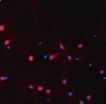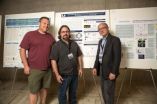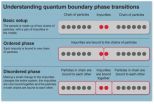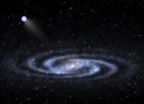(Press-News.org) In human cells, DNA occurs only in the cell nucleus as the carrier of genetic information. In order to protect it, specialized proteins regularly scan the individual strands for defects, and repair them. One example of this is the protein Rad50, a DNA sensor that binds to DNA and detects defective sites. A team of scientists headed by Prof. Jürgen Ruland of the TUM together with colleagues from the LMU have now discovered another important task performed by Rad50.
There is normally no DNA in the cytoplasm surrounding the cell nucleus. However, if any does turn up there, it is frequently foreign DNA from a virus, for instance, that has infected the cell. Just like humans, some types of viruses use DNA to carry their genetic information. Thus the innate immune system has developed alarm mechanisms to detect foreign DNA in cytoplasm quickly and effectively, and activate the immune system by producing messenger substances.
However, it remains largely unclear just how this activation process occurs in the cytoplasm. In their study, lead author Dr. Susanne Roth and her colleagues have now shown that the DNA sensor Rad50 from the cell nucleus is also an important trigger for antiviral defense. "It is very surprising even for us that Rad50, which specializes in DNA in the cell nucleus, also detects foreign viral DNA and acts as a connecting link for the corresponding immune response", says Prof. Jürgen Ruland, explaining the significance of the findings.
One protein - two functions
In their experiments, the participating scientists infected immune cells with a virus that introduced its DNA into the cytoplasm. They were able to show that Rad50 bound to the viral DNA in the cytoplasm, even though it normally docks onto damaged DNA in the cell nucleus. A crucial factor was that Rad50 interacted with a specific signal protein (CARD9) of the immune system at the same time, forming a complex. The researchers succeeded in demonstrating this connection in cells for the first time.
The formation of the complex activated a signal transduction pathway in the cell which ended with production of the messenger substance interleukin 1β. This vital "global player" of the immune system is responsible for the onset of fever as a defense mechanism against pathogens, but also has a role in autoimmune diseases, such as rheumatoid arthritis.
In order to confirm their results, the researchers then used cells containing either no Rad50 or no CARD9, and again introduced DNA into their cytoplasm. Both cell types then produced far less interleukin 1β, as the Rad50-CARD9 complex could not be formed in order to activate the alarm system.
"Too much or too little of IL-1β can lead to a defective immune response or chronic disease, so its production must be strictly regulated by the body", explains Jürgen Ruland. "Now that we know Rad50 and CARD9 are important triggers for the alarm system and IL-1β production, we can gain a better understanding of many immune responses and develop strategies to influence them therapeutically."
INFORMATION:
Original publication:
Susanne Roth, Andrea Rottach, Amelie S Lotz-Havla, Verena Laux, Andreas Muschaweckh, Søren W Gersting, Ania C Muntau, Karl-Peter Hopfner, Lei Jin, Katelynd Vanness, John H J Petrini, Ingo Drexler, Heinrich Leonhardt and Jürgen Ruland, Rad50-CARD9 interactions link cytosolic DNA sensing to IL-1β production, Nature Immunology, 2014.
DOI: 10.1038/ni.2888
Contact:
Prof. Jürgen Ruland
Institute of Clinical Chemistry and Pathobiochemistry
Klinikum rechts der Isar, Technische Universität München
Tel.: +49 89 4140 4751
jruland@lrz.tum.de
http://www.klinchem.med.tum.de
Starting signal for antiviral defense
Protein identified as important trigger of antiviral response
2014-05-07
ELSE PRESS RELEASES FROM THIS DATE:
Geniposide protects hippocampal neurons via the non-classical estrogen signaling pathway
2014-05-07
Amyloid-β (Aβ) plaques and neurofibrillary tangles are the main pathological hallmarks of Alzheimer's disease, as well as the loss of neurons and synapses. recent reports have shown that estrogen exerts neuroprotective effects. However, large clinical trials in postmenopausal women indicated adverse side-effects of estrogens, such as increased incidence of breast cancer and metrocarcinoma, thereby preventing clinical use of estrogen. Tongluojiunao (TLJN) is an herbal medicine consisting of two main components, geniposide and ginsenoside Rg1. Prof. Qian Hua and ...
Discovery offers new possibilities for clean energy research
2014-05-07
University of Houston physicists have discovered a new thermoelectric material offering high performance at temperatures ranging from room temperature up to 300 degrees Celsius, or about 573 degrees Fahrenheit.
"This new material is better than the traditional material, Bismuth telluride, and can be used for waste heat conversion into electricity much more efficiently," said Zhifeng Ren, M.D. Anderson Chair professor of physics at UH and the lead author of a paper describing the discovery, published online by Nano Energy.
Ren, who is also principal investigator at the ...
Ability to isolate and grow breast tissue stem cells could speed cancer research
2014-05-07
LA JOLLA—By carefully controlling the levels of two proteins, researchers at the Salk Institute have discovered how to keep mammary stem cells—those that can form breast tissue—alive and functioning in the lab. The new ability to propagate mammary stem cells is allowing them to study both breast development and the formation of breast cancers.
"What we've shown is that we can take these cells out of a mouse and study them and regulate them in the laboratory by providing them with a specific factor," says Peter C. Gray, a staff scientist in Salk's Clayton Foundation ...
Today's offenders are tomorrow's victims in gangs
2014-05-07
HUNTSVILLE, TX (5/7/14) -- Gang members are twice as likely to become both a victim and an offender of a crime than non-gang members, as single acts of violence often lead to retribution between gangs as a whole, according to a new study.
"In other words, gang members are not distinctly offenders or victims; instead, gang membership is a common source of both forms of violence," said David Pyrooz, an assistant professor at Sam Houston State University, College of Criminal Justice and principal author of the study. "Today's criminal offender is tomorrow's victim, and today's ...
Arctic study sheds light on tree-ring divergence problem
2014-05-07
SAN FRANCISCO -- Changes in tree-ring density in the Arctic may be evidence of changes in light intensity during the trees' growth, according to a new study by San Francisco State University researcher Alexander Stine.
The finding has direct implications for the tree-ring "divergence problem," a phenomenon that has received considerable media attention but has been widely misinterpreted, said Stine, an assistant professor of Earth & climate sciences.
Tree rings consist of a low density ring, which forms early in the growing season, and a high density ring that forms ...
Newly found dinosaur is long-nosed cousin of Tyrannosaurus rex
2014-05-07
Scientists have discovered a new species of long-snouted tyrannosaur, nicknamed Pinocchio rex, which stalked the Earth more than 66 million years ago.
Researchers say the animal, which belonged to the same dinosaur family as Tyrannosaurus rex, was a fearsome carnivore that lived in Asia during the late Cretaceous period.
The newly found ancient predator looked very different from most other tyrannosaurs. It had an elongated skull and long, narrow teeth compared with the deeper, more powerful jaws and thick teeth of a conventional T. rex.
Palaeontologists were uncertain ...
Melting an entire iceberg with a hot poker: Spotting phase changes triggered by impurities
2014-05-07
"What a curious feeling," says Alice in Lewis Carroll's tale, as she shrinks to a fraction of her size, and everything around her suddenly looks totally unfamiliar. Scientists too have to get used to these curious feelings when they examine matter on tiny scales and at low temperatures: all the behaviour we are used to seeing around us is turned on its head.
In research published today in the journal Nature Communications, UCL scientists have made a startling discovery about a familiar physical effect in this unfamiliar setting.
Phase transitions are a category of ...
Sprites form at plasma irregularities in the lower ionosphere
2014-05-07
Atmospheric sprites have been known for nearly a century, but their origins were a mystery. Now, a team of researchers has evidence that sprites form at plasma irregularities and may be useful in remote sensing of the lower ionosphere.
"We are trying to understand the origins of this phenomenon," said Victor Pasko, professor of electrical engineering, Penn State. "We would like to know how sprites are initiated and how they develop."
Sprites are an optical phenomenon that occur above thunderstorms in the D region of the ionosphere, the area of the atmosphere just above ...
International molecular screening program for metastatic breast cancer AURORA at IMPAKT
2014-05-07
While research has made great strides in recent decades to improve and significantly extend the lives of patients with early breast cancer, the needs of patients with advanced or metastatic disease have largely been ignored. Moreover, despite the fact that the overall breast cancer death rate has dropped steadily over the last decade and significant improvements in survival have been made, metastatic breast cancer represents the leading cause of death among patients with the disease.
In this context the Breast International Group (BIG) recently launched AURORA, which ...
Nearest bright 'hypervelocity star' found
2014-05-07
SALT LAKE CITY, May 7, 2014 – A University of Utah-led team discovered a "hypervelocity star" that is the closest, second-brightest and among the largest of 20 found so far. Speeding at more than 1 million mph, the star may provide clues about the supermassive black hole at the center of our Milky Way and the halo of mysterious "dark matter" surrounding the galaxy, astronomers say.
"The hypervelocity star tells us a lot about our galaxy – especially its center and the dark matter halo," says Zheng Zheng, an assistant professor of physics and astronomy and lead author ...
LAST 30 PRESS RELEASES:
Transforming acoustic waves with a chip
When climate risk hits home, people listen: Study reveals key to engagement with disaster preparedness messaging
Major breakthrough against diabetes thanks to a microbial molecule that disarms inflammation
Silicon chips on the brain: Researchers announce a new generation of brain-computer interface
Getting rest is the best
Towards sustainable organic synthesis – Mechanochemistry replaces lithium with sodium in organic reactions
Wireless device ‘speaks’ to the brain with light
Greenhouse gases to intensify extreme flooding in the Central Himalayas
New study sheds light on Milky Way's mysterious chemical history
Could altering the daily timing of immunotherapy improve survival in people with cancer?
Weaving secondary battery electrodes with fibers and tying them like ropes for both durability and performance
Using social media may impair children’s attention
Science briefing: An update on GLP-1 drugs for obesity
Lower doses of immunotherapy for skin cancer give better results
Why didn’t the senior citizen cross the road? Slower crossings may help people with reduced mobility
ASH 2025: Study suggests that a virtual program focusing on diet and exercise can help reduce side effects of lymphoma treatment
A sound defense: Noisy pupae puff away potential predators
Azacitidine–venetoclax combination outperforms standard care in acute myeloid leukemia patients eligible for intensive chemotherapy
Adding epcoritamab to standard second-line therapy improves follicular lymphoma outcomes
New findings support a chemo-free approach for treating Ph+ ALL
Non-covalent btki pirtobrutinib shows promise as frontline therapy for CLL/SLL
University of Cincinnati experts present research at annual hematology event
ASH 2025: Antibody therapy eradicates traces of multiple myeloma in preliminary trial
ASH 2025: AI uncovers how DNA architecture failures trigger blood cancer
ASH 2025: New study shows that patients can safely receive stem cell transplants from mismatched, unrelated donors
Protective regimen allows successful stem cell transplant even without close genetic match between donor and recipient
Continuous and fixed-duration treatments result in similar outcomes for CLL
Measurable residual disease shows strong potential as an early indicator of survival in patients with acute myeloid leukemia
Chemotherapy and radiation are comparable as pre-transplant conditioning for patients with b-acute lymphoblastic leukemia who have no measurable residual disease
Roughly one-third of families with children being treated for leukemia struggle to pay living expenses
[Press-News.org] Starting signal for antiviral defenseProtein identified as important trigger of antiviral response




